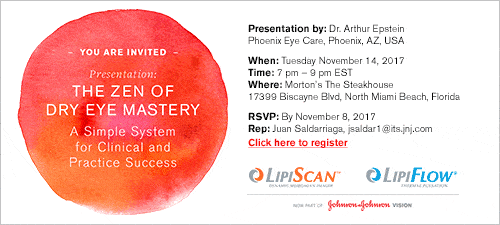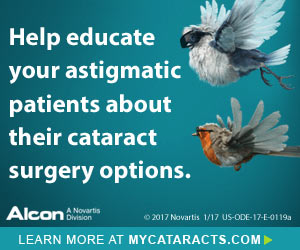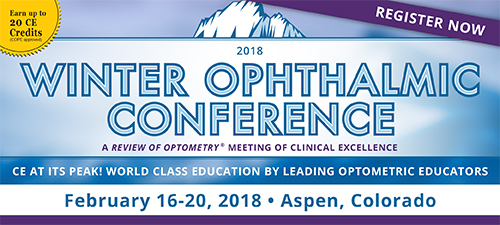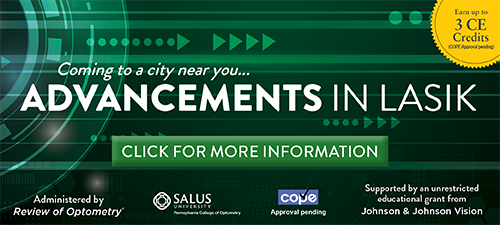
A
weekly e-journal by Art Epstein, OD, FAAO
Off the Cuff: Empowering the Future
Over the past few years I’ve cautioned that optometry is in for a wild ride. I speak to a lot of colleagues, and it has become increasingly obvious to all but those in deep denial that traditional optometric practice is serious trouble. We sit squarely in the crosshairs of well-funded adversaries that are intent upon deracinating traditional patient care models—especially our more mercantile elements.
|
|||||

|
||
| Evaluation of the Effect of Moist Chamber Spectacles in Patients with Dry Eye Exposed to Adverse Environment Conditions | ||||
This study evaluated the effect of moist chamber spectacle wear on the ocular surface and tear functions in a controlled wind exposure environment. Twenty-eight eyes of 14 probable dry eye subjects (four men, 10 women; mean age: 34.5 years) underwent constant wind exposure for 10 minutes without spectacles, with conventional spectacle wear and with moist chamber spectacle wear. Dryness Visual Analog Scale (VAS) scores, tear evaporation, blink rate, tear-film breakup testing and fluorescein staining were performed before and after wind exposure.
The mean dryness VAS score after wind exposure was significantly higher when no spectacles were worn or when conventional spectacles with no moist chambers were worn compared with after exposure scores when moist chamber spectacles were worn. The mean of tear evaporation rate from the ocular surface and blink rate increased significantly with wind exposure when no spectacles were worn or when conventional spectacles with no moist chambers were worn. There were no significant changes before and after wind exposure when the moist chamber spectacles were worn. Moist chamber spectacles appeared to have favorable effects on dry eye symptomatology, tear stability and blink rates in adverse environment conditions such as wind exposure. |
||||
SOURCE: Ogawa M, Dogru M, Toriyama N, et al. Evaluation of the effect of moist chamber spectacles in patients with dry eye exposed to adverse environment conditions. Eye Contact Lens. 2017; Oct 31. [Epub ahead of print]. |
||||
 |
||
Coordination of Gaze Behavior and Foot Placement During Walking in Persons with Glaucoma |
||||
Vision normally provides environmental information necessary to direct the foot to safe locations during walking. Peripheral visual field loss limits what a person can see, and may alter how a person visually samples the environment. Researchers tested the hypothesis that the spatial-temporal coupling between gaze and stepping in a precision-based walking task is altered in persons with glaucoma, particularly under dual-task situations, and results in reduced foot-placement accuracy. Twenty people with glaucoma and 20 normally sighted controls performed a precision walking task that involved stepping to the center of four targets under three conditions: targets only, walking and counting backwards to simulate a conversation, and walking while performing a concurrent visual search task to simulate locating a landmark. Researchers quantified foot placement error and error variability with respect to the targets, as well as saccade and fixation timing with respect to foot placement.
Compared with controls, people with glaucoma looked earlier at future stepping targets (with respect to toe-off of the foot) in the targets only and count conditions, and transferred gaze away sooner from the current stepping target in all conditions. Persons with glaucoma also had increased foot placement error, particularly in the count condition, and increased foot placement error variability compared with normally sighted controls. Glaucoma significantly disrupted gaze-foot coordination and resulted in less accurate foot placement when precision wass required during walking. Researchers wrote that this finding suggests that the risk of trips and falls might be heightened in this population. |
||||
SOURCE: Miller AB, Lajoie K, Strath RA, et al. Coordination of gaze behavior and foot placement during walking in persons with glaucoma. J Glaucoma. 2017; Nov 7. [Epub ahead of print]. |
||||
 |
||
| Comparison of Noncycloplegic and Cycloplegic Autorefraction in Categorizing Refractive Error Data in Children | ||||
To systematically analyze the differences between cycloplegic and noncycloplegic refractive errors (RE) in children and to determine if the predictive value of noncycloplegic RE in categorizing RE could be improved, random cluster sampling was used to select 6,825 children four to 15 years of age. Autorefraction was performed under noncycloplegic and cycloplegic (induced with 1% cyclopentolate drops) conditions. Paired differences between noncycloplegic and cycloplegic spherical equivalent (SE) RE were determined. A general linear model was developed to determine whether cycloplegic SE could be predicted using noncycloplegic SE, age and uncorrected visual acuity (UCVA).
Compared with cycloplegia, noncycloplegia resulted in a more myopic SE (paired difference: -0.63D ± 0.65D, 95% CI: -0.612 to -0.65D, 6017 eligible right eyes), with greater differences observed in younger participants and in eyes with more hyperopic RE and smaller AL. Using raw noncycloplegic data resulted in only 61% of the eyes being correctly classified as myopic, emmetropic or hyperopic. Using age and uncorrected VA in the model, the association improved, and 77% of the eyes were classified correctly. However, predicted cycloplegic SE continued to show large residual errors for low myopic to hyperopic RE. Applying the model to only those eyes with uncorrected VA <6/6 resulted in an improvement (R2 =0. 93), with 80% of the eyes correctly classified. A higher VA cutoff (i.e., ≤20/60) resulted in 97.5% of eyes classified correctly. Noncycloplegic assessment of RE in children overestimated myopia and resulted in a high error rate for emmetropic and hyperopic RE. Investigators wrote that adjusting for age and applying uncorrected VA cutoffs to noncycloplegic assessments improved detection of myopic RE, and might help in identifying myopic RE in situations where cycloplegia is not available. However, they added that it did not help in identifying the magnitude of refractive error, and, therefore, is of limited value. |
||||
SOURCE: Sankaridurg P, He X, Naduvilath T, et al. Comparison of noncycloplegic and cycloplegic autorefraction in categorizing refractive error data in children. Acta Ophthalmol. 2017;95(7):e633-e640. |
||||
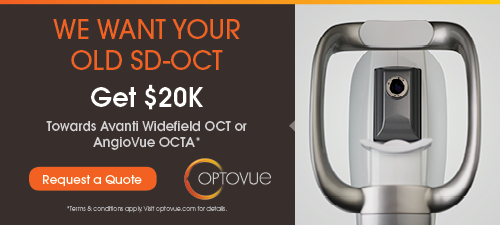 |
||
| News & Notes | |||||||||
| SCO Honors Farias with Lifetime Achievement Award Southern College of Optometry recently awarded its lifetime achievement award to Fred Farias III, OD, CEO of 20/20 Vision Care in McAllen, Texas. Dr. Farias was previously named 2015 Optometrist of the Year by the Texas Optometric Association and 2016 Optometrist of the Year by the American Optometric Association. He focuses his Texas practice on therapeutic optometry and optometric glaucoma, and is a member of SCO’s Alumni Council, the AOA Board of Trustees, and the AOA Federal Legislative Action and Keyperson committees. He is the immediate past president of the Texas Optometric Association and was a charter member of Optometry Cares - The AOA Foundation. Texas Governor Greg Abbott appointed Dr. Farias to the Texas Higher Education Coordinating Board. In addition, Dr. Farias organizes/sponsors vision screenings for underserved communities throughout south Texas and volunteers for the AOA Foundation’s InfantSEE program.
|
|||||||||
Tear Film Innovations Completes $9 Million Series A Funding
|
|||||||||
| AAO Honors Dr. Choi with Career Development Award Stacey S. Choi, PhD, was named by the American Academy of Optometry as the 2018 Academy Career Development Award recipient. The Academy will provide a maximum of $50,000 in direct costs per year for up to two years, potentially renewable once for a total of up to four years of funding. The Ohio State University will provide matching funds up to $50,000 per year. The funding will help support Dr. Choi’s research on cellular level structural changes in the retina associated with the onset and progression of myopia. Read more.
|
|||||||||
IDOC Hosts Its Fall Optometry Conference in Denver IDOC, a privately held alliance of U.S. independent optometrists, hosted more than 300 people during its fall national conference at the Grand Hyatt in Denver (Oct. 25 to 28). The conference kicked off with a welcome ceremony and talk from IDOC CEO and President Dave Brown, who presented “Focused on What Matters.” Other highlights included a celebration of the 10-year anniversary of Essilor Vision Foundation and World Sight Day. Read more.
|
|||||||||
AAO Makes Donation in Honor of Brien Holden Humanitarian Awardee Dr. Potter |
|||||||||
AAOF Announces Vincent Salierno Scholarship Recipients
|
|||||||||
LumiThera Unveils LIGHTSITE I Dry AMD Clinical Interim Data |
|||||||||
|
Optometric Physician™ (OP) newsletter is owned and published by Dr. Arthur Epstein. It is distributed by the Review Group, a Division of Jobson Medical Information LLC (JMI), 11 Campus Boulevard, Newtown Square, PA 19073. HOW TO ADVERTISE |


